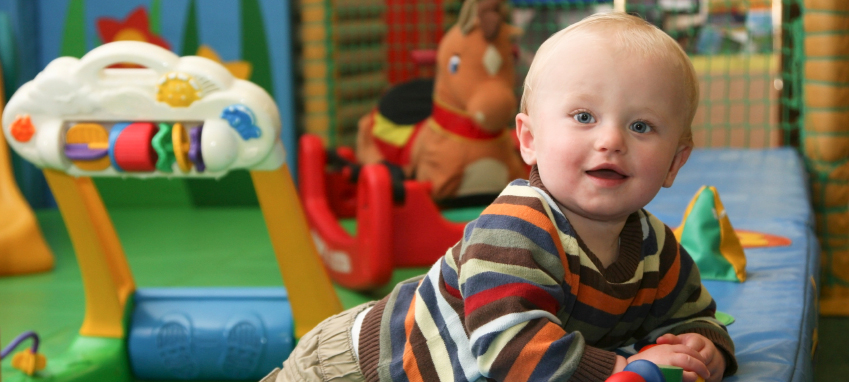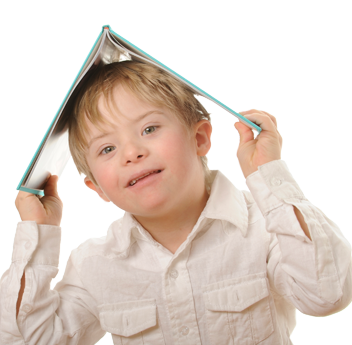Inclusive Child Care
Why is high-quality child care important for children with special needs?
Most children, including those with disabilities and special needs, spend some time in a child care environment during early childhood, as well as while attending school.
In a high-quality child care environment, child care providers respond positively to differences in children’s abilities, interests and experiences. Children with and without disabilities develop a greater appreciation of each other and of individual differences.
The focus is on planned developmental activities — individualized or in small groups. The environment provides needed predictability and routine, as well as novelty and stimulation. All inclusive environments allow children to grow and learn physically, emotionally, intellectually and socially alongside his/her peers.
It is important that the teacher and child develop a mutually respectful communication system, building and enhancing understanding and trust and leading to optimal development. Children who participate in high-quality child care programs are better prepared to enter elementary school and are more empowered to maximize their independence and acceptance into society.
All inclusive programs allow children to interact positively, make friends and learn from a diverse group of children in a “natural environment,” as provided for in federal law. Quality inclusive programs program must emphasizes health, nutrition and safety, as well as positive learning experiences.
Creating an Inclusive Environment
Inclusive practices create an environment in which children can work and play to their potential and are better able to understand and accept differences among themselves.
Use activities and materials that are well organized and accessible to all the children in your care.
Make sure there is enough space for children to move around (including children with wheelchairs or other assistive devices).
Use furniture and bathroom fixtures that are child size and durable.
Encourage each child to join his or her peers. Give children support to join others when it is needed.
Treat all children with respect. Don’t assume that children with disabilities can’t understand what you are saying about them to others.
Speak clearly when talking to children.
When talking to a child, allow time for him/her to respond to requests. Some children may need extra time to respond.
Point out strengths and successes of all children. Emphasize similarities among children.
Be consistent in routines and interactions.
Additional Resources
The National Dissemination Center for Children with Disabilities (NICHCY) offers a wealth of information on disabilities and serve the nation as a central source of information on disabilities in infants and toddlers. They provide easy-to-read information on Individuals with Disabilities Education Act (IDEA), the law authorizing early intervention services and special education. Their State Resource Sheets will help you connect with the disability agencies and organizations in Virginia. On September 30, 2013, funding for this program from the Office of Special Education Programs at the U.S. Department of Education ended. This rich website and all its free resources will remain available until September 30, 2014.
Children who are cared for together (whether or not they have disabilities):
- Feel a sense of belonging
- Have better self-esteem and confidence in their abilities
- Experience a wide variety of friendships
- Learn from and share experiences with other children
- Develop sensitivity towards others
- Appreciate differences in others and themselves
- Are encouraged to be resourceful, creative and cooperative
Caring for children with disabilities helps you:
- Build on your experience and skills
- Appreciate the differences and unique qualities in all individuals
- Enhance your child care business through new partnerships
- Tap into available community resources
- Strengthen your reputation as a child care professional
- Demonstrate your belief in equal opportunities and rights for all
Getting Started
Follow these steps to make yours an inclusive child care program:
-
- Check your policies and procedures to make sure they are open and inclusive to all children. Your policies must not screen out children with disabilities.
- Remove physical barriers to allow all children to participate. This can be as simple as rearranging a few pieces of furniture.
- When you get a call from a parent of a child with disabilities, ask about the child’s specific needs and arrange to meet the child and the parents.
- Make decisions about your ability to serve each child on a well- informed, individual basis. Children cannot be excluded from a child care setting simply because they have a disability.

Sample Inclusion Documents
Download a sample inclusion policy and a parent letter regarding inclusion practices below.
Sample Inclusion Policy
Provided to assist you in verifying that your program’s policies and procedures are open and inclusive to all children. >>>
Sample Parent Letter Regarding Inclusion Practices
Provided to assist you in better serving each child and their family. >>>
Inclusion Resources and Webinars
High Quality Inclusion Federal Series
This is a webinar series to hear from federal staff and other leaders in the field who share specific insights and information related to serving children with disabilities.
https://eclkc.ohs.acf.hhs.gov/children-disabilities/article/high-quality-inclusion-federal-series
The webinars include:
- Partnerships for Inclusion: Ensuring Access to High-Quality Evaluation and Services
- Supporting Participation for All Children: Essential Features of High-Quality Inclusion
- Collaboration with Families and Other Partners: Essential Features of High-Quality Inclusion
- Professional Development to Support Effective Inclusion Practices
Highly Individualized Practices Series
Find effective strategies that teachers, home visitors, and coaches can use in their efforts to support children with disabilities or suspected delays.
https://eclkc.ohs.acf.hhs.gov/children-disabilities/article/highly-individualized-practices-series
The webinars in this series include:
- Preventing Suspension and Expulsion of Children with Disabilities or Suspected Delays
- Supporting Interactions for Children with Disabilities or Suspected Delays
- Environments That Support High Quality Inclusion
- Practice-Based Coaching to Support Inclusion
Disabilities Dialogue
https://eclkc.ohs.acf.hhs.gov/children-disabilities/article/disabilities-dialogue
This webinar offers tips and tools for working with children with disabilities.
- Supporting Children with Disabilities Who Are Also Dual Language Learners
Early Care and Education Environment Indicators and Elements of High-Quality Inclusion
The Early Childhood Education Environment (ECEE) Indicators detail the key elements that are necessary for implementing high-quality inclusive practices in early childhood settings. They are designed to assist personnel in providing effective supports and services to young children with disabilities. It is assumed that all federal and state legal requirements are in place. These indicators are not meant to examine federal and state requirements. They are intended to enhance high-quality inclusive practices implemented by early care and education personnel.
Early Childhood Inclusion Materials
Special Quest: Including Infants and Toddlers with Disabilities
These sessions examine the beliefs and attitudes that influence and affect adults and children in inclusive settings. They provide numerous practical strategies and tools to help families and providers implement high-quality inclusive services.
Extension Alliance for Better Child Care
https://childcare.extension.org/adapting-the-child-care-environment-for-children-with-special-needs/
This article shares how to adapt the child care environment for children with special needs by focusing on both general modifications as well as modifications for specific disabilities.
Fact Sheets about Specific Disabilities
Each fact sheet defines the disability, describes its characteristics, offers tips for parents and teachers, and connects you with related information and organizations with special expertise in that disability. Fact sheets available in Spanish.
Challenging Behavior: Prevention Strategies for Children with Disabilities
Children often engage in challenging behaviors because there is a message they are trying to communicate. In this webinar, listen as presenters discuss prevention strategies for challenging behaviors. Also, learn the types of support teachers can provide for an array of children’s needs.
https://eclkc.ohs.acf.hhs.gov/video/challenging-behavior-prevention-strategies-children-disabilities
Offering Support during Mealtimes and Snacks
Children with disabilities may need additional assistance with eating and drinking. This information is helpful to teaching staff and parents when planning adequate supports and adaptations for children with disabilities during mealtimes.
https://eclkc.ohs.acf.hhs.gov/children-disabilities/article/offering-support-during-mealtimes-snacks
Integration Checklist: Including Children with Significant Disabilities in Head Start
Checklist helps staff members understand how to make sure children can communicate, socialize, and engage in child care settings and activities.
Embedded Learning Opportunities for Infants and Toddlers
This article discusses how to include learning opportunities throughout the day to offer infants and toddlers with disabilities additional chances to learn and practice new skills. There are videos included which show embedding in action.
Disabilities That Qualify Infants, Toddlers, Children, and Youth for Services under IDEA 2004
Blindness/Visual Impairment
Cerebral Palsy
Deaf-Blindness
Deafness and Hearing Loss
Developmental Delays
Down Syndrome
Epilepsy
Intellectual Disability
Learning Disability
Physical Disability
Social and Emotional Disability
Other Health Impairments: Hemophilia
Other Health Impairments: Sickle Cell Anemia
Other Health Impairments: Speech and Language Impairments
How Can You Find Out Additional Information Regarding the Americans with Disabilities Act (ADA)?

The Department of Justice provides information about the Americans with Disabilities Act (ADA) through a toll-free ADA Information Line. This service permits businesses, state and local governments, or others to call and ask questions about general or specific ADA requirements including questions about the ADA Standards for Accessible Design.
ADA Specialists are available Monday through Friday from 9:30 a.m. until 5:30 p.m. (Eastern Time) except on Thursday when the hours are 12:30 p.m. until 5:30 p.m. Spanish language service is also available. For general ADA information, answers to specific technical questions, free ADA materials, or information about filing a complaint, call: (800) 514-0301 (voice) or (800) 514-0383 (TTY).
What the ADA requires:
The Americans with Disabilities Act (ADA) is a law that protects people from discrimination based on disability. This law says that public accommodations must be accessible to people with disabilities. Privately-run child care centers and family day care homes are considered public accommodations and must comply with the ADA.
When changes are needed:
In order to serve children with disabilities, the ADA requires child care providers to make reasonable modifications required to accommodate children with disabilities. This means making changes that are accomplished without excessive difficulty or expense.
Whether a change is unduly burdensome is determined by the type and cost of what is needed in light of the resources available to individual child care centers and homes. Some possible accommodations may include:
Revision of policies and procedures Curriculum adaptations
Additional Staff Training
Removal of physical barriers
Be clear about rules and expectations. Provide logical and natural consequences that relate directly to a child’s specific actions.
Try different ways to communicate. When you are getting ready to read to the group, show a photo of children sitting together for story time, or use a picture of the outdoors to let children know that the group is going outside.
Answer children’s questions in a straightforward manner. For example, if a child asks you, “Why doesn’t Susie talk?” say, “Susie doesn’t talk because she doesn’t hear like you. She hasn’t had a chance to learn to talk with words. Susie is learning to use her hands to talk.”
Give positive attention to children when they try new activities, play well with others, show creativity, or make progress in learning new concepts and skills.
Take time to build a relationship with each child in your care.


